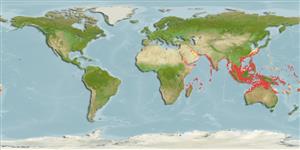Teleostei (teleosts) >
Kurtiformes (Nurseryfishes, cardinalfishes.) >
Apogonidae (Cardinalfishes) > Apogoninae
Etymology: More on author: Day.
Issue
Synonym of Jaydia truncata according to Mabuchi et al., 2014 (Ref. 96888).
Environment: milieu / climate zone / depth range / distribution range
Ecology
Marine; reef-associated; depth range 18 - 106 m (Ref. 26165). Tropical; 32°N - 22°S
Indo-West Pacific: East Africa to the southern Marshall Islands, north to southern Japan, south to the Arafura Sea (Ref. 9819) and northwestern Australia. Also reported from New Caledonia (Ref. 26587). Occurrence in Taiwan needs confirmation.
Size / Weight / Age
Maturity: Lm ? range ? - ? cm
Max length : 16.0 cm TL male/unsexed; (Ref. 4749)
Normally found in sandy to muddy bottoms. Has luminous organs on the thorax and abdomen which contain luciferin obtained from Cypridina plankton. Nocturnal species (Ref. 7300).
Life cycle and mating behavior
Maturities | Reproduction | Spawnings | Egg(s) | Fecundities | Larvae
Mouthbrooders (Ref. 240). Distinct pairing during courtship and spawning (Ref. 205).
Myers, R.F., 1991. Micronesian reef fishes. Second Ed. Coral Graphics, Barrigada, Guam. 298 p. (Ref. 1602)
IUCN Red List Status (Ref. 130435)
Threat to humans
Harmless
Human uses
Tools
Special reports
Download XML
Internet sources
Estimates based on models
Preferred temperature (Ref.
123201): 24.3 - 28.6, mean 27.5 °C (based on 744 cells).
Phylogenetic diversity index (Ref.
82804): PD
50 = 0.5000 [Uniqueness, from 0.5 = low to 2.0 = high].
Bayesian length-weight: a=0.01023 (0.00653 - 0.01603), b=3.03 (2.90 - 3.16), in cm total length, based on LWR estimates for this species & (Sub)family-body (Ref.
93245).
Trophic level (Ref.
69278): 3.6 ±0.6 se; based on diet studies.
Resilience (Ref.
120179): High, minimum population doubling time less than 15 months (Preliminary K or Fecundity.).
Fishing Vulnerability (Ref.
59153): Low vulnerability (10 of 100).
Nutrients (Ref.
124155): Calcium = 90.3 [57.2, 149.5] mg/100g; Iron = 0.81 [0.53, 1.26] mg/100g; Protein = 19.1 [18.1, 20.1] %; Omega3 = 0.183 [0.122, 0.269] g/100g; Selenium = 35.1 [20.9, 60.6] μg/100g; VitaminA = 85.9 [33.2, 222.9] μg/100g; Zinc = 1.48 [1.06, 2.00] mg/100g (wet weight);
